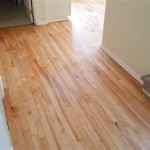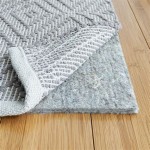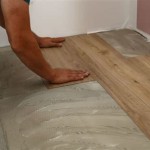How To Remove Rug Tape From Hardwood Floors
Adhesive residue left behind by rug tape on hardwood floors is a common household problem. While rug tape serves a useful purpose in preventing rugs from slipping and causing accidents, its adhesive can bond tenaciously to the floor's finish, leaving behind a sticky, unsightly mess. Successfully removing this residue requires patience, the right tools, and appropriate techniques to avoid damaging the hardwood floor.
Hardwood floors, with their natural beauty and durability, add value to a home. However, they are susceptible to scratches, discoloration, and damage from harsh chemicals or abrasive cleaning methods. Therefore, it is crucial to approach the removal of rug tape residue with caution and a methodical approach.
The type of rug tape used, the duration it was adhered to the floor, and the type of finish on the hardwood all influence the difficulty of the removal process. Some tapes leave behind a light residue that is easily wiped away, while others create a stubborn bond that requires more aggressive techniques. Identifying the type of residue and the floor's finish is the first step in choosing the appropriate removal method.
Before attempting any removal method, it is essential to test it on an inconspicuous area of the hardwood floor. This allows for an assessment of any potential damage to the finish, such as discoloration, dulling, or scratching. A hidden area, such as under a piece of furniture or in a closet, is ideal for this purpose. If the test area shows adverse effects, a different removal method should be considered.
Key Point 1: Understanding the Type of Residue and Floor Finish
The success of rug tape residue removal hinges on accurately identifying the type of adhesive left behind and the type of finish applied to the hardwood floor. Water-based adhesives typically leave a cloudy residue that can often be dissolved with water and a mild detergent. Solvent-based adhesives, on the other hand, leave behind a stickier, more persistent residue that requires stronger solvents for removal.
Hardwood floor finishes vary widely, from polyurethane to varnish to penetrating oil finishes. Polyurethane is a durable, protective coating that resists damage from most cleaning solvents. Varnish is similar to polyurethane but may be more susceptible to certain solvents. Penetrating oil finishes, such as tung oil or linseed oil, soak into the wood and provide a natural, matte finish. These finishes are generally more vulnerable to damage from solvents and require more gentle cleaning methods.
To determine the type of adhesive, examine the residue closely. Water-based adhesives often appear milky or cloudy, while solvent-based adhesives are usually clear and sticky. Consulting the rug tape's packaging or manufacturer's website may provide additional information. Identifying the floor's finish can be more challenging. If the original installation documentation is available, it may specify the type of finish used. Alternatively, a flooring professional can inspect the floor and provide an assessment.
Incorrectly identifying the adhesive or the finish can lead to using inappropriate cleaning methods, which can damage the floor. If unsure about either, err on the side of caution and start with the gentlest methods first.
Key Point 2: Gentle Removal Methods
Before resorting to harsh chemicals or abrasive tools, several gentle removal methods can be attempted. These methods are less likely to damage the hardwood floor's finish and are often effective for removing lighter residue.
Warm Water and Mild Dish Soap: This is the simplest and often most effective method for removing water-based adhesive residue. Mix warm water with a few drops of mild dish soap. Dip a soft cloth into the solution, wring out the excess water, and gently rub the affected area. Avoid saturating the wood with water, as this can cause damage. Repeat the process until the residue is softened and can be wiped away. Dry the area thoroughly with a clean cloth.
Vinegar Solution: White vinegar is a mild acid that can help dissolve some types of adhesive residue. Mix equal parts white vinegar and warm water. Apply the solution to the affected area using a soft cloth, allowing it to sit for a few minutes to soften the residue. Gently rub the area with the cloth, and then wipe clean with a damp cloth. Dry thoroughly.
Hair Dryer: The heat from a hair dryer can soften the adhesive, making it easier to peel away. Hold the hair dryer a few inches away from the residue and apply heat for several seconds. Use a plastic scraper or a credit card to gently lift the edge of the residue and peel it away. Be careful not to overheat the area, as this could damage the floor's finish. Continue heating and scraping until all the residue is removed.
Ice Pack: In some cases, freezing the adhesive can make it brittle and easier to remove. Place an ice pack on the affected area for several minutes. The cold will harden the adhesive, allowing it to be chipped away with a plastic scraper. Be careful not to scratch the floor with the scraper.
These gentle methods should be attempted first before moving on to more aggressive techniques. They are less likely to damage the hardwood floor and may be sufficient to remove the rug tape residue.
Key Point 3: Stronger Removal Methods
If gentle methods fail to remove the rug tape residue, stronger methods may be necessary. However, these methods should be used with caution, as they carry a higher risk of damaging the hardwood floor's finish.
Mineral Spirits: Mineral spirits, also known as paint thinner, is a solvent that can dissolve many types of adhesive residue. Before using mineral spirits, ensure adequate ventilation in the area. Apply a small amount of mineral spirits to a clean cloth and gently rub the affected area. Avoid pouring mineral spirits directly onto the floor. Allow the mineral spirits to sit for a few minutes to soften the residue. Wipe clean with a damp cloth and dry thoroughly. Always test mineral spirits in an inconspicuous area first to ensure it does not damage the floor's finish.
Rubbing Alcohol (Isopropyl Alcohol): Rubbing alcohol is another solvent that can be effective for removing adhesive residue. Apply rubbing alcohol to a clean cloth and gently rub the affected area. Like mineral spirits, avoid pouring rubbing alcohol directly onto the floor. Allow it to sit for a few minutes to soften the residue. Wipe clean with a damp cloth and dry thoroughly. Test in an inconspicuous area first.
Goo Gone or Similar Adhesive Removers: Commercial adhesive removers like Goo Gone are specifically designed to dissolve adhesive residue. Follow the manufacturer's instructions carefully. Typically, these removers are applied to the affected area, allowed to sit for a few minutes, and then wiped away with a clean cloth. It is crucial to test these products in an inconspicuous area first, as some may damage the floor's finish. Always clean the area with a damp cloth and dry thoroughly after using an adhesive remover.
Plastic Scraper and Heat Gun: If chemical solvents are not effective, a combination of heat and a plastic scraper can be used. Use a heat gun on a low setting to gently heat the adhesive residue. Avoid overheating the area, as this could damage the floor's finish. As the adhesive softens, use a plastic scraper to gently lift and remove it. Be careful not to scratch the floor with the scraper. Clean the area with a damp cloth and dry thoroughly.
When using stronger removal methods, it is essential to wear appropriate safety gear, such as gloves and eye protection. Work in a well-ventilated area to avoid inhaling harmful fumes. Always test the method in an inconspicuous area first and proceed with caution.
Following any removal method, it is advisable to clean the entire area with a hardwood floor cleaner to remove any remaining residue and restore the floor's shine. Apply the cleaner according to the manufacturer's instructions and dry the floor thoroughly.
Preventing rug tape residue in the future is always preferable to attempting to remove it. Consider using rug pads instead of rug tape. Rug pads provide cushioning and prevent rugs from slipping without leaving behind adhesive residue. If rug tape is necessary, choose a low-adhesive tape specifically designed for hardwood floors. Regularly check the tape and replace it before it becomes difficult to remove. Addressing residue promptly can also prevent it from becoming more stubborn and difficult to remove over time.

How To Remove Double Sided Carpet Tape Hometalk

Easy Ways To Get Rid Of Carpet Tape On Wooden Floors Or Stairs Floor Sanding

Removing Carpet Tape From Hardwood Floors Or Stairs

Carpet Tape Removal Demonstration

Best Cleaner Ever To Remove Sticky Tape From Floors Etc Safe Easy

Flooring Tips How To Remove Tape From A Hardwood Floor

How To Remove Carpet Tape From A Wood Floor Without Damage

Best Cleaner Ever To Remove Sticky Tape From Floors Etc Safe Easy

Easy Way To Remove Tape Residue Goo Gone

How To Remove Deteriorated Rug S Latex Backing Stuck On Hardwood Flooring Between Naps The Porch
See Also







